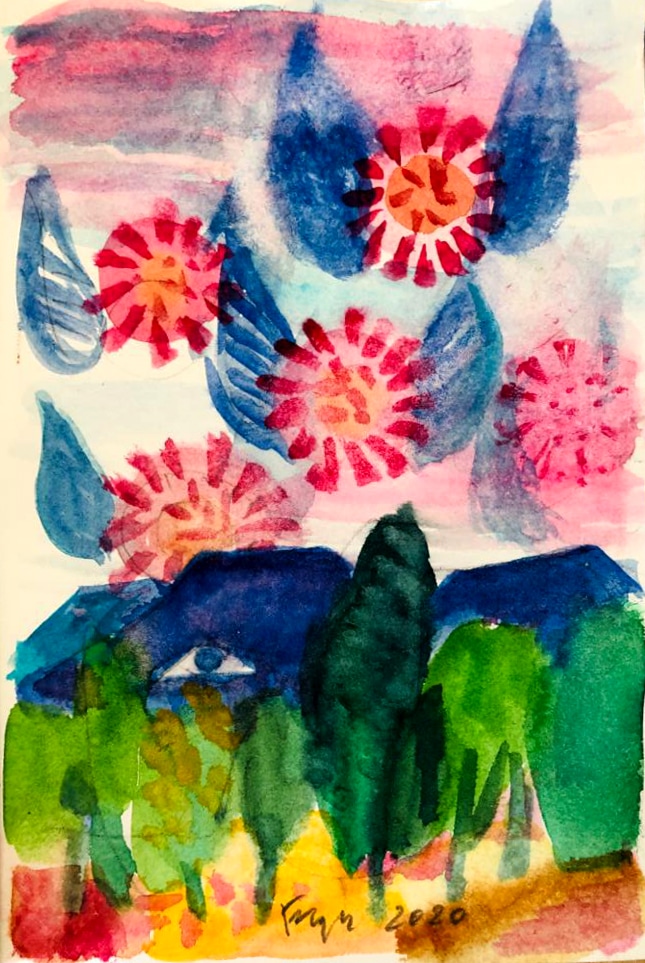CORONA IX
2020
WATERCOLOR ON PAPER
21 x 13 cm
The artist Andreas Felger paints nine watercolors in March 2020, in which he deals with the spread of the Corona virus and how it affects his own as well as social life. Nine motifs, which will be followed by others, under the title CORONA, which show social, individual as well as nature-related life situations, all of which are permeated by the “one” virus, COVID-19, which encompasses and dominates all and everything. The artist shows the virus in a kind of exuberant star, whose oversized form shows not only its real, but also its media size, which it has now attained.
Of the nine pictorial motifs, eight show typical human reaction patterns to the existence of the deadly virus. From initial arrogant and gregarious doubts (keyword: Corona parties) in the face of expert advice, to fears and states of panic in the face of unexpected viral illness, to grief over the loss of fellow human beings, the artist shows the broad spectrum of human behavior in the face of the growing threat posed by the virus and how it increasingly dominates social and individual life in a restrictive manner.
These are disturbing motifs because, on the one hand, the consistently color-intensive and color-expressive subjects reflect the plump, rich, and socially (digitally) networked life of the West to which many of us are accustomed, and, on the other hand, the creeping process of decomposition of the deadly virus gradually becomes visible and tangible. If at first the threat still hovers over the social network of families, towns, villages, clubs, religious communities, companies, regulars’ tables, parties, brothels and all other forms of social interaction, it gradually creeps in and disintegrates the familiar and thus reliable patterns of our relationship structures. Couples move away from each other, not because they are at odds, but because the viral disease makes contact impossible. Urban life is disintegrating because all places of social interaction are being closed down, and professional life, where at all possible, is taking place mainly in home offices far away from the company in order to avoid possible chains of infection. People isolate themselves in their private and professional lives, are in state-imposed or self-imposed quarantine alone with their fears and panics, and in the worst case die isolated in a hospital ward, without support and comfort. In death, togetherness is again possible.
In striking contrast to these eight gloomy pictorial subjects is the ninth pictorial motif. It stands out from all the others in that it does not depict a social situation, but a landscape. Above blue mountains, green forests, reddish-brown fields in a purple sky hover oversized five coronaviruses like stars, all with angel wings, as if they came to bring blessings to nature and to tell her: “Do not be afraid”.
What is a threat to human existence in the face of the virus seems to be a blessing for nature. Mountains awaken, fauna and flora blossom, the sky becomes clearer, rivers, streams and groundwater recover from the burdens of sewage and garbage, in short: the earth breathes a sigh of relief while man groans under the yoke of the virus. In the form of the virus, nature is reclaiming what man has denied it in many places.
Or one could think, provided that one believes in a creator God, that this straight makes a correction of its original plan and puts down humans, whom it had once thought as crown of the creation, or lets it pause at least for a time, in order to think again about its responsibility intended for it. In view of unprecedented destruction of nature, overpopulation and industrially controlled food production it would be urgently time for it. The ‘progress’ stagnates, the human being pauses and perhaps he uses the chance to reflect on his responsibility for the earth. Seen in this way, the virus attack would be a blessing and a chance for nature and for man, who himself is also nature.
by Kurt Freitag

